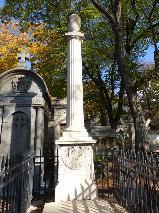Caulaincourt, Armand Augustin Louis de, Duc de Vicenza |
| MARSHAL, DIPLOMAT (FRANCE) |
|
BORN 9 Dec 1773, Caulaincourt, Aisne - DIED 19 Feb 1827, Paris CAUSE OF DEATH cancer of the stomach GRAVE LOCATION Paris: Père Lachaise, Rue du Repos 16 (division 29, chemin des Chèvres. ligne 02 (M: T-31)) |
|
Armand de Coulaincourt was the son of Louis Gabriel de Caulaincourt, the Marquis de Caulaincourt. When he was fifteen years old, he entered the army as an aide to his father. When the war of 1792 broke out, he was a captain. Before he could start serving as a soldier he was imprisoned because he was an aristocrat. He escaped and returned to the army. He served under general Lazare Hoche and was promoted to colonel in the Army of the Rhine. He saw action in thirteen campaigns and was wounded twice. In 1801 Napoleon sent him to Saint Petersburg and after his return be became aide-de-camp of Napoleon. He was involved in bringing the Duc d'Enhien to Paris in 1804 and when he heard of his execution he wept openly because he felt he had been used and it haunted him for rest of his life. In 1807 he was sent to Saint Petersburg as ambassador and in 1808 he was created Duke of Vicenza. In Russia he became a friend of Alexander I. In 1812 he warned Napoleon against his plans to invade Russia but the emperor did not listen. He was with him during the Battle of Borodino on 7 September 1812, where his younger brother Auguste-Jean-Gabriel de Caulaincourt (1777-1812) was killed. When Moscow was conquered, he warned the emperor against staying in Russia during the winter and he advised Napoleon to return to Paris. He accomapnied him on his way back in December 1812. After Duroc's death he became Grand Marshal of the Palace and was responsible for all diplomatic negotiations. He represented France at the Treaty of Fontainebleau on 10 April 1814 and was able to negotiate Elba for Napoleon. He lived in retirement until Napoleon returned in 1815. During the 100 Days he was minister of foreign affairs and tried to convince Europe in vain that Napoleon's intentions were now peaceful. But his official letters were ignored and probably not even opened. Napoleon gave him the title of Pair de France early in June 1815. After the Battle of Waterloo he was on a list to be arrested and executed, but although Alexander I refused to receive him he removed his name from the list. He lived in retirement in Paris afterwards and he used his notes from his conversations with Napoleon for a memoir. But publication was postponed, and the memoir was lost until it was rediscovered during the First World War. In 1933 it was finally published by Jean Hanoteau as "With Napoleon in Russia". Many German officers read it during the German invasion of Russia. He died in 1827 in Pairs and was buried in Père Lachaise. His eldest son was a senator during the Second Empire. Family • Father: Caulaincourt, Gabriel Louis, 4e Marquis de Related persons • worked for Napoleon I Bonaparte |
Sources • Armand-Augustin-Louis de Caulaincourt - Wikipedia (EN) • John Quincy Adams: American eyewitness of the Hundred Days | Cairn.info |



